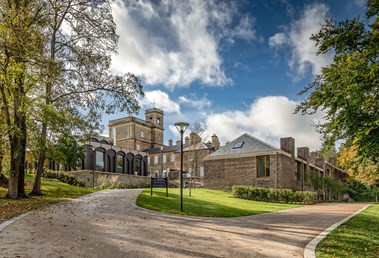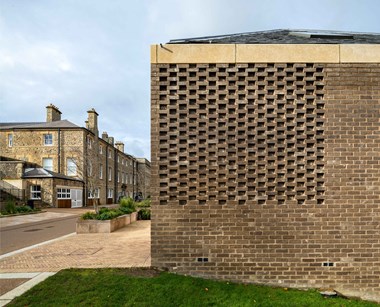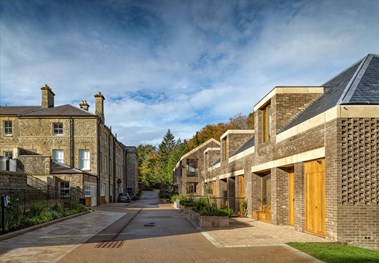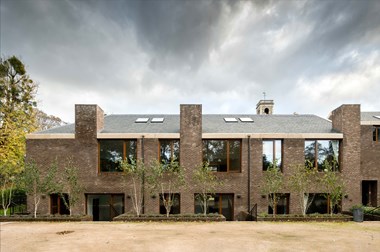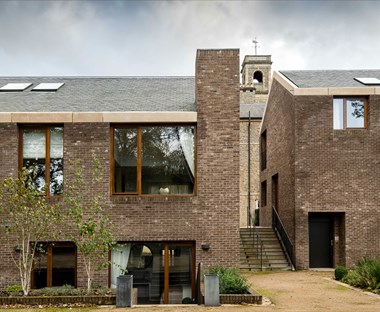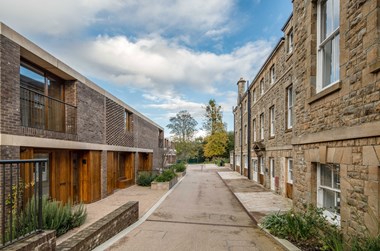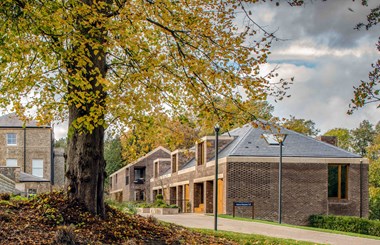Design Case Study: Wildernesse House Mews, Sevenoaks
A new mews-style development within the setting of a Grade II listed mansion and within an area of historic landscape.
This case study is one of ten studies of new residential or mixed-use developments compiled in 2020 by Purcell on behalf of Historic England.
Project information
- Region: South-East
- Type of development: Semi-rural and parkland sites
- Location and postcode: Sevenoaks, Kent, TN15 0EB
- Local planning authority: Sevenoaks District Council
- Architects: Morris + Company
- Developer/land owner: Pegasus Life
- No. of residential units: 8
- Site area: 20 hectares (total application site)
- Other uses: Care, fitness and social facilities
Description of development
Wildernesse House was formerly in use as a residential college for blind students. The site was acquired for redevelopment as an extra care retirement community, providing quality accommodation within an attractive setting and with first-class facilities. The scheme included the demolition of detracting 20th-century buildings, refurbishment of the main house, reinstatement of key views across the landscape and construction of new dwellings.
Heritage assets affected
The 18th-century Wildernesse House is listed at Grade II. The eastern half of the site is located within the Wildernesse Conservation Area, which is characterised by rural lanes, pockets of woodland and Arts & Crafts-influenced architecture. The Seal Conservation Area (a traditional medieval village) is located close by to the north.
Planning context
The site is located within the Green Belt and the Kent Downs Area of Outstanding Natural Beauty, and also has a number of Tree Preservation Orders in place. No specific allocation policies were in place and the application was determined against local and national policy. Extensive pre-application dialogue, including site visits and workshops, was carried out with the local planning authority prior to submission.
Assessment of design qualities and relationship to historic environment
The eight mews houses form one part of a wider masterplan for the Wildernesse estate. A core principle of the scheme was the removal of the 20th-century buildings and additions made by the site’s previous occupants, which had resulted in a detracting institutional character. A detailed assessment of the landscape informed by historic research resulted in the identification of four distinct character areas. Each of these character areas had different capacities to accommodate change and the masterplan for the site was subsequently adapted to best suit each area. The listed mansion and its immediate setting formed one of these groups.
There was previously a detached stable block range on the north side of the mansion. This was recognised as having little heritage value and identified as an opportunity for demolition and location for new residential units. These have been designed in a mews style to reflect the traditionally ancillary character of this space compared to the formal landscaping wrapping around the mansion.
To promote social interaction and create a sense of place, the mews houses are laid out to form a streetscape. To break up the street line and take a form that sits comfortably with the landscape, the terraces are staggered and set into the base of the sloping mound on which the mansion is positioned. The massing of the blocks is further broken down into a combination of different heights, aided by the existing topography and design features such as dormer windows.
There is an Arts and Crafts influence across the estate, especially further south where a series of rural lanes leading to individual houses set within generous green plots were laid out in the 1920s. This Arts and Crafts influence has been referenced in the contemporary design of the mews houses, particularly with the inclusion of strong corner chimneystacks, eaves windows and hipped roofs. The exteriors are faced with a grey-brown brick flecked with white pigmentation which adds texture and variety, and strong concrete bandings across the elevations reference the characteristic ashlar banding on the neighbouring mansion. Areas of lattice motif in the brickwork add visual interest to these facades.
The Arts and Crafts tradition has influenced the design intent for other developments across the estate, according to the different character areas. This has been balanced with the overarching objective of re-opening key views towards and out from the mansion in order to re-affirm the relationship between the listed building and its setting. Inside the mansion, ill-conceived modern partitions and other institutional features have been removed to better reveal its historic plan form, creating a series of residential units and communal facilities.
Key points
The success of the mews houses on the Wildernesse estate stems from their recognition of setting and early assessment of where change could be comfortably accommodated across the site at the same time as enhancing the setting of the listed house. The combined team of design, heritage and landscape disciplines has enabled a strongly holistic approach to the historic environment, balancing the needs of the brief with the constraints of the site.
Views of Wildernesse House Mews, Sevenoaks
Please click on the gallery images to enlarge.
Design in the historic environment: more case studies
-
Design in the Historic Environment
Principles and case studies for good practice in design when making changes to the built historic environment.
-
Design in the Historic Environment: Case Studies
Download all ten case studies as a PDF document.
-
Design Case Study: Roussillon Park Chichester, West Sussex
A case study of design in the historic environment: Roussillion Park is a modern residential complex at the site of a former barracks in Chichester.
-
Bourne Estate, Holborn, London
An award-winning residential extension on a Grade II listed urban estate, bringing together old and new through quality detailing and landscaping.
-
Design Case Study: 168 Upper Street, Islington
A case study of an imaginative reinstatement of a missing corner building in Islington that reproduces the original facade.
-
Temple Gardens, Temple Cloud
Design case study of the refurbishment and viable reuse of a listed pub, with a sensitive scheme of new housing and hotel development.
-
Fairmile Hospital
Case study of the re-development of a former hospital on the edge of a rural village with new homes designed as distinctive groups.
-
Garden Quarter, Caversfield
Case study for design in the historic environment of the sensitive redevelopment of a former Royal Air force site into a residential community.
-
Church Fields, Boston Spa
A design case study featuring a residential extension to the edge of an historic village that interprets traditional architectural forms.
-
Timekeepers Square, Salford
Case study of a redevelopment that recreates the vernacular Georgian terrace and urban grain within the setting of a listed church.
-
Welsh Streets Liverpool 8
Case study of an ambitious and popular scheme that converts hundreds of derelict Victorian terraced houses.


